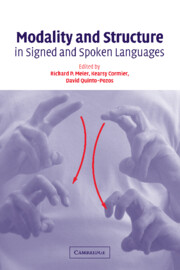Book contents
- Frontmatter
- Contents
- List of figures
- List of tables
- List of contributors
- Acknowledgements
- 1 Why different, why the same? Explaining effects and non-effects of modality upon linguistic structure in sign and speech
- Part I Phonological structure in signed languages
- Part II Gesture and iconicity in sign and speech
- Part III Syntax in sign: Few or no effects of modality
- Part IV Using space and describing space: Pronouns, classifiers, and verb agreement
- 13 Pronominal reference in signed and spoken language: Are grammatical categories modality-dependent?
- 14 Is verb agreement the same crossmodally?
- 15 The effects of modality on spatial language: How signers and speakers talk about space
- 16 The effects of modality on BSL development in an exceptional learner
- 17 Deictic points in the visual–gestural and tactile–gestural modalities
- Index
- References
15 - The effects of modality on spatial language: How signers and speakers talk about space
Published online by Cambridge University Press: 22 September 2009
- Frontmatter
- Contents
- List of figures
- List of tables
- List of contributors
- Acknowledgements
- 1 Why different, why the same? Explaining effects and non-effects of modality upon linguistic structure in sign and speech
- Part I Phonological structure in signed languages
- Part II Gesture and iconicity in sign and speech
- Part III Syntax in sign: Few or no effects of modality
- Part IV Using space and describing space: Pronouns, classifiers, and verb agreement
- 13 Pronominal reference in signed and spoken language: Are grammatical categories modality-dependent?
- 14 Is verb agreement the same crossmodally?
- 15 The effects of modality on spatial language: How signers and speakers talk about space
- 16 The effects of modality on BSL development in an exceptional learner
- 17 Deictic points in the visual–gestural and tactile–gestural modalities
- Index
- References
Summary
Introduction
Most spoken languages encode spatial relations with prepositions or locative affixes. Often there is a single grammatical element that denotes the spatial relation between a figure and ground object; for example, the English spatial preposition on indicates support and contact, as in The cup is on the table. The prepositional phrase on the table defines a spatial region in terms of a ground object (the table), and the figure (the cut) is located in that region (Talmy 2000). Spatial relations can also be expressed by compound phrases such as to the left or in back of. Both simple and compound prepositions constitute a closed class set of grammatical forms for English. In contrast, signed languages convey spatial information using so-called classifier constructions in which spatial relations are expressed by where the hands are placed in the signing space or in relationship to the body (e.g. Supalla 1982; Engberg-Pedersen 1993). For example, to indicate ‘The cup is on the table,’ an American Sign Language (ASL) signer would place a C classifier handshape (referring to the cup) on top of a B classifier handshape (referring to the table). There is no grammatical element specifying the figure–ground relation; rather, there is a schematic and isomorphic mapping between the location of the hands in signing space and the location of the objects described (Emmorey and Herzig in press). This chapter explores some of the ramifications of this spatialized form for how signers talk about spatial environments in conversations.
- Type
- Chapter
- Information
- Modality and Structure in Signed and Spoken Languages , pp. 405 - 421Publisher: Cambridge University PressPrint publication year: 2002
References
- 12
- Cited by



